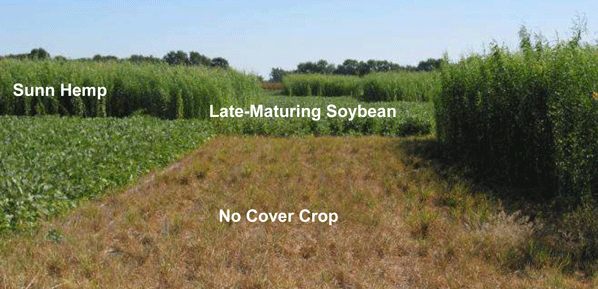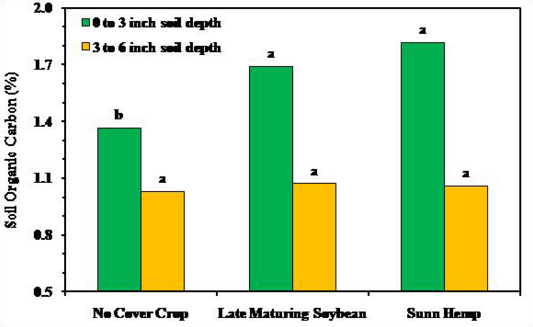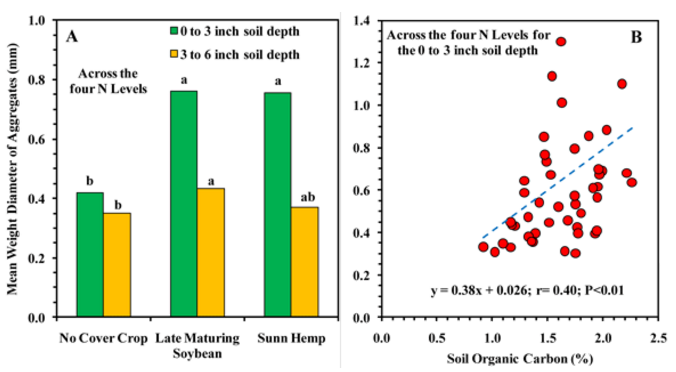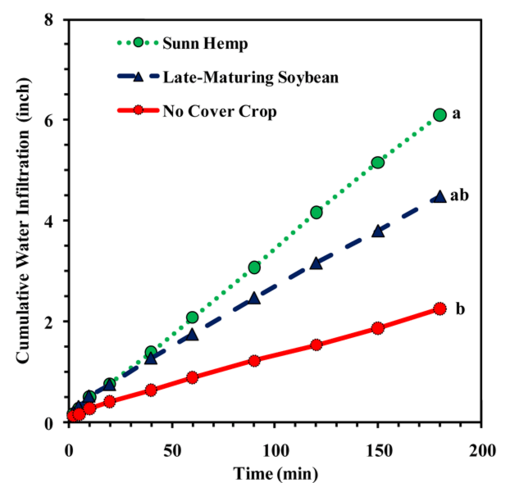By DeAnn Presley, Extension Soil Management Specialist
Dec. 23, 2015 — Cover crops can have several potential benefits for soil quality in a no-till rotation.
Greater biomass input from cover crops can potentially increase soil organic carbon (C) concentration, enhance nutrient cycling, regulate soil temperature, and help protect the soil from water and wind erosion.
In short, cover crops may improve soil physical properties by increasing soil organic C concentration.
But there is surprisingly little scientific documentation of these effects. Because changes in soil properties tend to happen very gradually, data from long-term cover crop experiments can provide insights into the potential of cover crops for improving soil functions.
A few years ago, Kansas State agronomists measured the effects of cover crops on soil physical properties and studied relationships between crop-induced changes in soil organic C concentration and soil physical properties on a long-term cover crop experiment at the former Harvey County Experiment Field in Hesston (Figure 1).
Figure 1. Cover crop experiment at the former Harvey County Experiment Field in Hesston.

The experiment was initially established in 1995 with hairy vetch as a winter cover crop following winter wheat in a wheat/grain sorghum rotation compared to the same rotation without a cover crop. Management involved reduced-tillage and four levels of N fertilizer at 0, 30, 60, and 90 lb/acre. This system was tested through 2000.
Starting in 2002, sunn hemp and late-maturing soybean as summer cover crops replaced hairy vetch, with all phases of the experiment managed exclusively under no-till. Other treatments (N rates and the no-cover-crop check) were kept the same. Sunn hemp and late-maturing soybean were planted after wheat in early summer, terminated in September or October, and grain sorghum was planted in June of the following year.
Crop Yields
In 6 site-years during the period 2002 through 2008, soybean and sunn hemp produced dry matter yields of 2.42 and 3.43 ton/acre with total N contents of 111 and 134 lb/acre, respectively. Overall, both cover crops had a positive impact on grain sorghum yield, particularly at N rates of 60 lb/acre or less.
At the highest N rate of 90 lb/acre, the soybean cover crop didn’t increase sorghum yields. However, sunn hemp tended to result in a sorghum yield benefit even at the highest N rate, over the 6-year average. Averaged over N rates, soybean and sunn hemp resulted in 6-year average grain sorghum yield increases of 8.8 and 14.9 bu/acre, respectively.
Positive residual effects of soybean and sunn hemp cover crops on the yield of wheat after sorghum were small and mostly observed at N rates of 60 lb/acre or less. Five-year mean wheat yields combined from the two sites and averaged over N rate indicated increases of 2.2 and 2.9 bu/acre in rotations with soybean and sunn hemp vs. no cover crop.
Soil Organic Carbon
Sunn hemp and late-maturing soybean cover crops increased soil organic C concentration relative to plots without cover crops. Averaged across N rates, soil organic C concentration in the 0 to 3 inch soil depth was 30% greater in sunn hemp and 20% greater in late-maturing soybean plots than in plots without cover crops (Figure 2). Cover crops did not, however, affect organic C concentration in the 3 to 6 inch depth.
Figure 2. Effects of cover crops on soil organic C concentration at two soil depths. Bars with the same letter within the same depth are not significantly different.

Aggregate Stability
Cover crops improved soil wet aggregate stability in the 0 to 3 inch depth (Figure 3A). The proportion of macroaggregates was greater in cover crop plots than in plots with no cover crops. The increase in soil organic C concentration with cover crops was partly responsible for the improved aggregate stability (Figure 3B).
Figure 3. Wet aggregate stability expressed as mean weight diameter of aggregates (A) and relationship between aggregate stability and cover crop-induced increase in soil organic C concentration (B). Bars with the same letter within the same depth are not significantly different.

Water Infiltration
Sunn hemp increased water infiltration by about three times when compared with plots without cover crops. Cumulative water infiltration was greater in sunn hemp than in no-cover crop plots by about 3 times (Fig. 4). Late-maturing soybeans had less effect on water infiltration than sunn hemp. Water infiltration rate was positively correlated with an increase in soil organic C concentration.
Figure 4. Cumulative water infiltration for the three cover crop treatments. Means with the same letter are not significantly different.

Soil Compaction
Soils with cover crops were less compactable in the 0 to 3 inch depth than soils without cover crops. At 0 lb/acre of N, maximum soil compactability was about 5% lower under cover crops than under plots without cover crops. At 60 lb/acre of N, soil compactability was not, however, affected by cover crops.
Maximum soil compactability was negatively correlated with soil organic C concentration. This indicates that the increase in soil organic C concentration from the use of cover crop plots was partly responsible for the reduced soil compactability in plots with cover crops.
Earthworm Abundance
Averaged across all N rates, sunn hemp led to higher total earthworm numbers, followed by soybeans and no cover. A separate article in this issue of the Agronomy eUpdate (No. 542) addresses this in detail. The eUpdates are available at: https://webapp.agron.ksu.edu/agr_social/eu.throck
Cover Crop Residues
Sunn hemp produced more residue than late-maturing soybean. Averaged across the three previous rotation cycles and N rates, sunn hemp produced 3.13 tons/acre of residues while late-maturing soybean produced 2.37 tons/acre.
Thus, the greater benefits of sunn hemp than late-maturing soybean for increasing water infiltration may be due to the greater residue input with sunn hemp. Both cover crops, however, had significant benefits on reducing soil compactability, improving aggregate stability, and increasing soil organic C concentration.
Nitrogen Fertilization
Nitrogen application did not affect aggregate stability, but it did help reduce soil compactability and increase organic C concentration in the 0 to 3 inch depth.
When averaged across the four N rates, aggregate stability was positively correlated with organic C concentration, which indicates that cover crops can indeed improve aggregate stability by increasing organic C concentration. Looking at the specific N rates, the same effects occurred at the 0 lb/acre N rate.
At 30, 60, and 90 lb/acre of N, however, aggregate stability was not significantly correlated with organic C concentration. This suggests that the increase in organic C concentration from the use of cover crops possibly diminished, to some degree, with N fertilization. The same is true for cash crop yields; the benefits of cover crops decrease as N fertilization rate decreased.
Summary
Addition of cover crops enhanced no-till performance. It improved soil physical and hydraulic properties, and increased soil organic C concentration near the soil surface. Results suggest cover crops may reduce some risks of excessive near-surface soil compaction and help improve soil structure in no-till systems.
Cover crops, particularly sunn hemp, may reduce runoff and soil loss by increasing water infiltration. The improvements in soil physical properties are directly related to increases in soil organic C concentration. Results suggest cover crops should be used as companion to no-till systems to enhance the potential of no-till technology for improving soil properties.






Post a comment
Report Abusive Comment